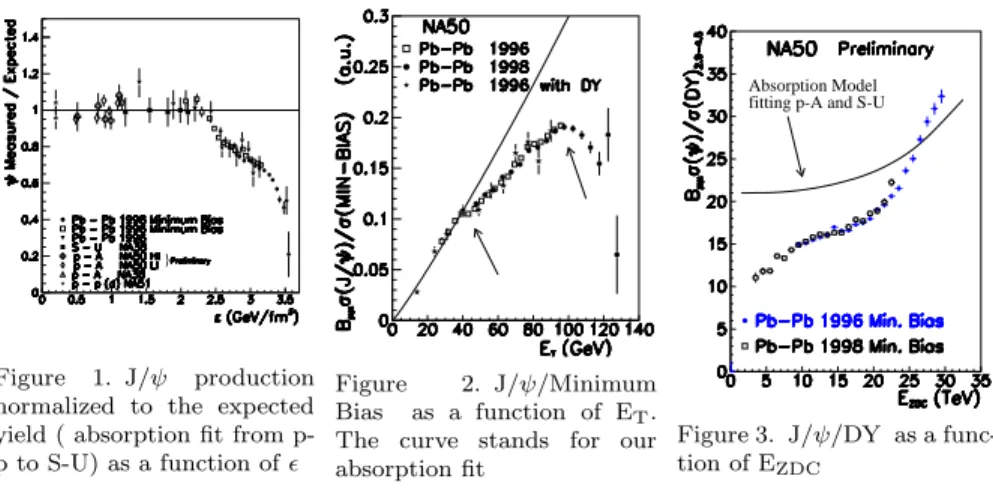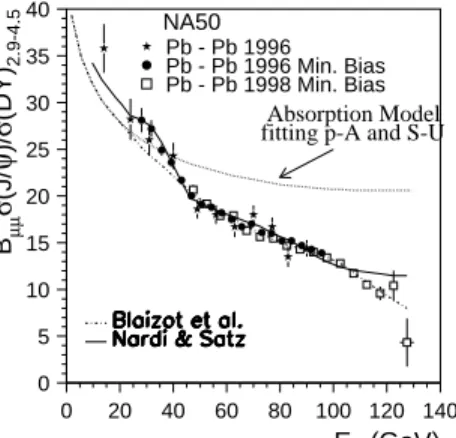arXiv:hep-ph/0111429v1 29 Nov 2001
Presented by S´ERGIO RAMOS6,b NA50 Collaboration
M.C. Abreu6,a, B. Alessandro10, C. Alexa3, R. Arnaldi10, M. Atayan12, C. Baglin1, A. Baldit2, M. Bedjidian11, S. Beol`e10, V. Boldea3, P. Bordalo6,b, S.R.Borenstein9,c, G. Borges6, A. Bussi`ere1, L. Capelli11, J. Castor2, C.Castanier2,
B. Chaurand9, B. Cheynis11, E. Chiavassa10, C. Cical`o4, T. Claudino6, M.P. Comets8 , N. Constans9 , S. Constantinescu3 , P. Cortese10 , J. Cruz6 , N. De Marco10 , A. De Falco4 , G. Dellacasa10,d, A. Devaux2 , S. Dita3 , O. Drapier11 , B. Espagnon2 , J. Fargeix2 , P. Force2 , M. Gallio10 , Y.K. Gavrilov7 , C. Gerschel8 , P. Giubellino10 , M.B. Golubeva7 , M. Gonin9 , A.A. Grigorian12 , S. Grigorian12 , J.Y. Grossiord11 , F.F. Guber7 , A. Guichard11 , H. Gulkanyan12 , R. Hakobyan12 , R. Haroutunian11
, M. Idzik10,e, D. Jouan8
, T.L. Karavitcheva7 , L. Kluberg9 , A.B. Kurepin7 , Y. Le Bornec8 , C. Louren¸co5 , P. Macciotta4 , M. Mac Cormick8 , A. Marzari-Chiesa10 , M. Masera10 , A. Masoni4 , M. Monteno10 , A. Musso10 , P. Petiau9, A. Piccotti10, J.R. Pizzi11, W.L. Prado da Silva10,f, F. Prino10, G. Puddu4, C. Quintans6, S. Ramos6,b, L. Ramello10,d, P. Rato Mendes6, L. Riccati10, A. Romana9, H. Santos6, P. Saturnini2, E. Scalas10,d, E. Scomparin10,
S. Serci4, R. Shahoyan6,g, F. Sigaudo10, S. Silva6, M. Sitta10,d, P. Sonderegger5,b, X. Tarrago8, N.S. Topilskaya7, G.L. Usai4, E. Vercellin10, L. Villatte8, N. Willis8 1 LAPP, CNRS-IN2P3, Annecy-le-Vieux, France; 2 LPC, Universit´e Blaise Pascal and CNRS-IN2P3, Aubi`ere, France; 3
IFA, Bucharest, Romania; 4
Universit`a di Cagliari/INFN, Cagliari, Italy; 5
CERN, Geneva, Switzerland; 6
LIP, Lisbon, Portu-gal; 7
INR, Moscow, Russia; 8
IPN, Univ. de Paris-Sud and CNRS-IN2P3, Orsay, France; 9 LPNHE, Ecole Polytechnique and CNRS-IN2P3, Palaiseau, France; 10 Uni-versit`a di Torino/INFN, Torino, Italy; 11
IPN, Universit´e Claude Bernard Lyon-I and CNRS-IN2P3, Villeurbanne, France; 12
YerPhI, Yerevan, Armenia.
aalso at FCT, Universidade de Algarve, Faro, Portugal; balso at IST, Universidade T´ecnica de Lisboa, Lisbon, Portugal; con leave of absence from York College CUNY; dUniversit`a del Piemonte Orientale, Alessandria and INFN-Torino, Italy; e also at Fac. Physics and Nuclear Techniques, Univ. Mining and Metallurgy, Cracow, Poland; f now at UERJ, Rio de Janeiro, Brazil; g on leave of absence of YerPhI, Yerevan, Armenia.
The J/ψ production in 158 A GeV Pb-Pb interactions is studied, in the dimuon decay channel, as a function of centrality, as measured with the electromagnetic or with the very forward calorimeters. After a first sharp variation at mid cen-trality, both patterns continue to fall down and exhibit a curvature change at high centrality values. This trend excludes any conventional hadronic model and is in agreement with a deconfined quark-gluon phase scenario. We report also preliminary results on the measured charged multiplicity, as given by a dedicated detector.
1 Introduction
NA50 is a dimuon experiment searching for specific signals of deconfinement, namely the predicted suppression of charmonia production. Indeed, it has been predicted1 that the c¯c bound states are prevented to be formed by the colour screening potential in the very dense medium undergoing a phase tran-sition to a deconfined medium of quarks and gluons.
2 Experimental setup and data selection
The NA50 apparatus2 mainly consists of a muon spectrometer, a segmented active target and three independent centrality detectors: an electromagnetic calorimeter which measures the neutral transverse energy (ET) produced in the interaction, a zero degree calorimeter measuring the very forward hadronic energy (EZDC) of the spectator nucleons and a silicon strip multiplicity detec-tor.
In this analysis we use data taken in 1996 and 1998 with a lead beam impinging on a Pb target, as well as the new p-A data of 1998-2000 (A ≡ Be, Cu, Al, Ag, W, Pb) taken at two different beam intensities.
The kinematical domain used for dimuon detection, 2.92 ≤ ylab ≤ 3.92 and |cos θCS| < 0.5 leads, in the mass region of interest, to acceptances of the order of 15%. The centrality detectors cover the following rapidity domains: e.m. calorimeter, 1.1 < ηlab < 2.3 ; zero degree calorimeter, ηlab > 6.3 ; multiplicity detector, 0.82 < ηlab< 4.18 .
The J/ψ is detected via its decay into muon pairs. Combinatorial back-ground, due to π and K decays, is estimated from like-sign pairs2, using NBG = 2
√
N++N−− . The muon pairs selected for the analyses satisfy the standard NA50 criteria3.
3 J/ψ production analyses
A study of Drell-Yan behaviour, from p-p and several p-A systems to S-U and Pb-Pb, proves that its cross-section behaves normally and is proportional to the number of elementary nucleon-nucleon collisions4 . Thus, it can be used as a J/ψ reference.
A J/ψ systematic study is performed5 using all our previous data from lighter systems, ranging from p-p to S-U (NA387,8,9 and NA5110). The data are described by a simple exponential parametrization: Bµµσψ/σDY ∝ e−ρLσabs (L being the path length of the pre-resonant state in nuclear matter), giving an absorption value of the c¯cg state in nuclear matter of σabs = 5.8 ± 0.6 mb (full calculation gives 6.4 ± 0.5 mb). It is the normal J/ψ suppression.
tion fit from p-p to S-U, as a function of the energy density ǫ (evaluated by the Bjorken’s model), putting together all our systems, from p-p to Pb-Pb6. Whereas the more peripheral Pb-Pb points lie on the absorption curve, the more central ones show a sudden 20% drop at 2.3 GeV/fm3 followed by an inflection point at 3.1 GeV/fm3. It is the anomalous J/ψ suppression.
}
Figure 1. J/ψ production normalized to the expected yield ( absorption fit from p-p to S-U) as a function of ǫ
Figure 2. J/ψ/Minimum Bias as a function of ET. The curve stands for our absorption fit
Absorption Model fitting p-A and S-U
Figure 3. J/ψ/DY as a func-tion of EZDC
The J/ψ production is also studied, normalized to the minimum bias cross-section, as a function of ET(Fig. 2). Once again, a clear departure from our absorption fit at 40 GeV (corresponding to L = 8 fm) and an inflection point at 90 GeV followed by a steady steep decrease are observed, reinforcing the idea of the onset of another J/ψ suppression mechanism.
Finally, J/ψ/DY is studied as a function of an independent centrality variable, as given by a different detector, the forward hadronic calorimeter (Fig. 3). One observes, again, the stepwise J/ψ suppression pattern.
Figures 4 and 5 show the comparision of J/ψ production with some mo-dels: on the left, models11,12,13,14 assume that J/ψ is absorbed by comovers; on the right, models15,16 assume quark-gluon deconfinement. One sees that the J/ψ stepwise suppression pattern rules out any of these hadronic models, and may be explained in the framework of quark-gluon deconfinement, as melting of charmonium states.
4 Multiplicity distributions
Charged particle multiplicities dNch/dη were also studied, using the multi-plicity detector2, which is approximately centered at mid-rapidity. For this analysis, 2.2 η units were used: 1.89 ≤ ηlab≤ 4.18 .
0 5 10 15 20 25 30 35 40 0 20 40 60 80 100 120 140 ET (GeV) B σ (J/ ψ ) / σ (DY) 2.9-4.5 NA50 Pb - Pb 1996 Pb - Pb 1996 Min. Bias Pb - Pb 1998 Min. Bias
Figure 4. The J/ψ/DY stepwise pat-tern compared with conventional (hadronic) models based on comovers
0 5 10 15 20 25 30 35 40 0 20 40 60 80 100 120 140 ET (GeV) Bµµ σ (J/ ψ )/ σ (DY) 2.9-4.5 NA50 Pb - Pb 1996 Pb - Pb 1996 Min. Bias Pb - Pb 1998 Min. Bias Absorption Model fitting p-A and S-U
Figure 5. The J/ψ/DY stepwise pattern compared with models assuming deconfine-ment
Events were subdivided in 7 contiguous EZDC regions, as defined by our forward hadronic calorimeter (ZDC). This allows the definition of centrality classes, of about 5% σineleach.
Multiplicity distributions were fitted with gaussians (see Fig. 6), from which we evaluate the peak positions, ηmax, and obtain the maximum values of the charged particle densities, dNch/dη|max.
Figure 6. Pseudorapidity peak positions, ηmax, as a function of the forward energy EZDC
Figure 7. Number of charged particles at peak, dNch/dη|max, as a function of EZDC For all centrality classes, peak positions are compatible with a constant value of 3.10, in agreement with VENUS 4.12 Monte-Carlo17expectations.
collisions as compared to peripheral ones.
The pseudorapidity density of Nch, that is, the dNch/dη|maxvalues show a linear behaviour with centrality, evaluated by the forward energy measured with ZDC calorimeter (Fig. 7).
5 Conclusions
Concerning J/ψ production, three different types of analysis have been per-formed, namely J/ψ cross-section normalized to the Drell-Yan one as a func-tion of two independent centrality variables (the transverse energy measured with the electromagnetic calorimeter, and the very forward energy evaluated with the zero degree calorimeter) and J/ψ cross-section normalized to the minimum bias one, as a function of ET . They all agree with the observed stepwise pattern of the anomalous J/ψ suppression: a drop of about 20% and an inflection point followed by a steady steep decrease. Hadronic models with comovers can not describe our data (systems ranging from p-p and several p-A to S-U and Pb-Pb), which can be interpreted as melting of charmonium states in a deconfined medium.
Concerning multiplicity studies, one notices that the η peak position stays constant for all centrality classes (as predicted by VENUS Monte-Carlo) and observes an approximately linear increase of dNch/dη with centrality (EZDC). References
1. T. Matsui and H. Satz, Phys. Lett. B 178, 416 (1986).
2. M.C. Abreu et al. (NA50 Coll.), Phys. Lett. B 410, 327 (1997). 3. M.C. Abreu et al. (NA50 Coll.), Phys. Lett. B 410, 337 (1997). 4. S. Ramos et al. (NA50 Coll.) in ICHEP98, Vancouver, Canada, 1998. 5. M.C. Abreu et al. (NA50 Coll.), Phys. Lett. B 450, 456 (1999). 6. M.C. Abreu et al. (NA50 Coll.), Phys. Lett. B 477, 28 (2000). 7. M.C. Abreu et al. (NA38 Coll.), Phys. Lett. B 444, 516 (1998). 8. M.C. Abreu et al. (NA38 Coll.), Phys. Lett. B 449, 128 (1999). 9. M.C. Abreu et al. (NA38 Coll.), Phys. Lett. B 466, 408 (1999). 10. M.C. Abreu et al. (NA51 Coll.), Phys. Lett. B 438, 35 (1998). 11. C. Spieles et al., Phys. Rev. C 60, 54901 (1999).
12. D.E. Kahana et al., P. P. Nucl. Phys. 42, 269 (1999). 13. N. Armesto et al., Phys. Rev. C 59, 395 (1999). 14. A. Capella et al., Phys. Rev. Lett. 85, 2080 (2000). 15. M. Nardi and H. Satz, Phys. Lett. B 442, 14 (1998). 16. J.P. Blaizot et al., Phys. Rev. Lett. 85, 4012 (2000). 17. K. Werner, Phys. Rep. 32, 87 (1993).

